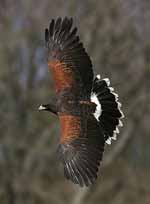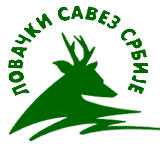
The Harris's Hawk or Harris Hawk, Parabuteo unicinctus, formerly known as the Bay-winged Hawk or Dusky Hawk, is a medium-large bird of prey which breeds from the southwestern United States south to Chile and central Argentina. Birds are sometimes reported at large in Western Europe, especially Britain, but it is a popular species in falconry and these records almost certainly all refer to escapes from captivity. It is the only member of the genus Parabuteo. The name is derived from the Greek para, meaning beside, near or like, and the Latin buteo, referring to a kind of buzzard; uni meaning once; and cinctus meaning girdled, referring to the white band at the base of the tail. John James Audubon gave this bird its English name in honor of his ornithological companion, financial supporter, and friend Edward Harris. The Harris Hawk is famous for its remarkable behavior of hunting cooperatively in "packs", consisting of family groups. (Most raptors are solitary hunters.) Individuals range in length from 46 to 76 cm (18 to 30 in) and generally have a wingspan of 1.1 m (3.6 ft) They exhibit sexual dimorphism with the females being larger by about 40%. In the United States, the average weight for males is about 710 g (25 oz), while the female average is 1,020 g (36 oz). They have dark brown plumage with chestnut shoulders, wing linings, and thighs, white on the base a tip of the tail, long, yellow legs and a yellow cere. The vocalizations of the Harris's Hawk are very harsh sounds. Hunting While most raptors are solitary, only coming together for breeding and migration, Harris's Hawks will hunt in cooperative groups of two to six. This is an adaptation to the desert climate in which they live. In one hunting technique, a small group flies ahead and scouts, then another group member flies ahead and scouts, and this continues until prey is bagged and shared. In another, all the hawks spread around the prey and one individual flushes it. The wild Harris's Hawk population is declining due to habitat loss; however, under some circumstances, Harris's Hawks have been known to move into developed areas. Adult male Since about 1980, Harris's Hawks have been increasingly used in falconry and are now the most popular hawks in the West (outside of Asia) for that purpose, as they are the easiest to train and the most social.








